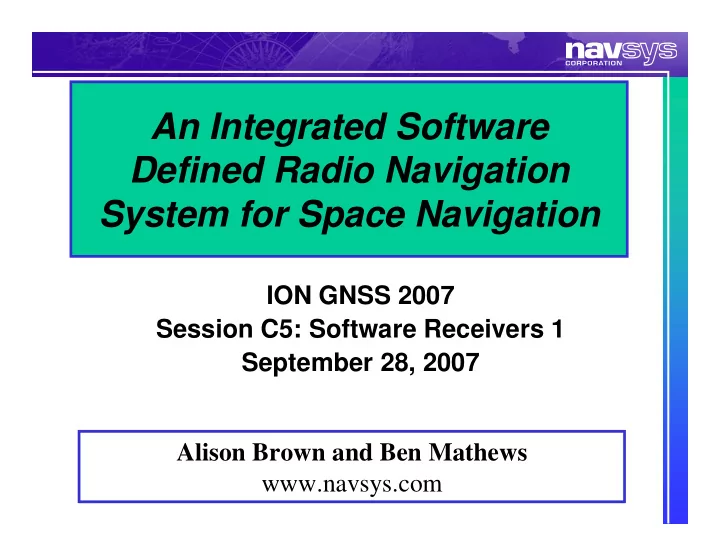

An Integrated Software Defined Radio Navigation System for Space Navigation ION GNSS 2007 Session C5: Software Receivers 1 September 28, 2007 Alison Brown and Ben Mathews www.navsys.com
Problem Statement • Existing space-qualified attitude control and navigation solutions are not suitable for deployment on microsatellites due to size, weight, power, and cost constraints • Small spacecraft require higher bandwidth attitude control authority due to faster response needed to counter disturbance forces • A small, flexible, and low-cost attitude control and navigation solution is required to support future microsatellite missions and applications
Benefits of a Software Defined Radio (SDR) Navigation Approach Multiple Software Easy Frequencies Flexible control of SDR integration of supported by waveform configuration additional flexible processing and operation sensors and RF/Digital using components Transceivers FPGAs
Integrated GPS / INS / Star-Tracker NAVSYS PC-104 GPS RF GPS DAE (L1) / Antenna DAE Passive Adptr PC-104 Oven Controlled CAC Board Crystal Oscillator NAVSYS Interface Fujitsu Hard Drive SPI Module (80 GB) MEMS IMU ADL PC-104 12 VDC Power Supply Power (5V & 12V Out) 1 PPS ADL855 PC-104 (Windows, RTX) Ethernet Microcosm Parvus SpacePC Spacecraft I/F PC-104+ (400 MHz Celeron) MicroMak Star Sensor
PC/104 SDR Components GPS DAE MicroMak Board Star-Tracker NAVSYS Oscillator Board DAE Adapter and GPS DAE PC/104+ CAC X ilxinx 2000 FPGAs P502 Pow erPC M ain Board Pentium IV NAVSYS Custom PC/104+ Adapter Board SBC GM S IO Board M ounting Plate Crista CAC FPGA MEMS IMU Board
Digital Antenna Element and Correlator Accelerator Card • Digital Antenna Element • Front-end down-conversion and digitization • Frequency/waveform agile • Beamsteering/Beamforming • GPS Correlator Accelerator Card • Firmware-based correlations under SW control • Can support other signal processing besides GPS • Snapshot acquisition for external post-processing
Integrated Navigation Filter • Must gracefully fuse data from multiple and disparate sensors into an integration attitude and navigation solution • GPS – Satellite pseudorange / carrier-phase measurements • Star-Tracker – Low-rate, high precision attitude estimates for in-orbit operations • IMU – High rate inertial information during orbit insertion and augmentation of star- tracker during satellite in-orbit maneuvering
InterNav Modular Inertial Navigation Product • Integrates GPS, inertial, and a variety of other sensor data • PR/DR or Pos/Vel • ∆θ , ∆ V from gyros and accels • Modular design facilitates integration of different sensors • Was modified under this effort to integrate star- tracker data into the combined navigation solution • Performs inertial navigation functions • Uses Kalman Filter for applying GPS updates • Can be configured to optimize performance based on sensor characteristics
Filter Implementation ˆ ˆ ∆ G G X INS X INS N Q ∆ θ b ∆ ∆ v v
NAVSYS Advanced GPS Hybrid Simulator (AGHS) • Simulator control provided through Matlab/Simulink interface • Open architecture to facilitate integration with trajectory generators • Precise digital signal generation under software control • Multiple antenna elements for wavefront simulation (8+) • Jammer simulation • Simulated inertial output • Simulated star-tracker output
AGHS Simulink Interface • Provides a user-friendly interface for simulation control and analysis • Open, flexible architecture supports easy modification for prototyping – This architecture was leveraged for rapid insertion of star-tracker simulation capability
AGHS Test Set-Up
AGHS HWIL Test Architecture D/A and Tune to RF Phase-Coherent Mixing AGHS Control Logic
GPS Tracking Results
Integrated Filter Test Results
Importance of Star-Tracker Input Without Star-Tracker With Star-Tracker 5 Attitude Error: InterNav GPS/INS/ST vs. INSSIM Trajectory Truth x 10 10 Ψ x Ψ y 8 Ψ z 6 σ -x σ -y Attitude Error [micro-rad] σ -z 4 Required 2 0 -2 -4 -6 -8 2000 2200 2400 2600 2800 3000 3200 Receiver Time Since T 0 = 475269.990 (s)
Conclusions • Prototype integrated space navigation receiver has been developed and tested • Benefits of star-tracker integration into navigation filter have been shown • Provides an affordable navigation option for low-cost microsatellite missions • Future efforts are focusing on radiation hardening and incorporation of NAVSYS IMU
Questions?
Recommend
More recommend